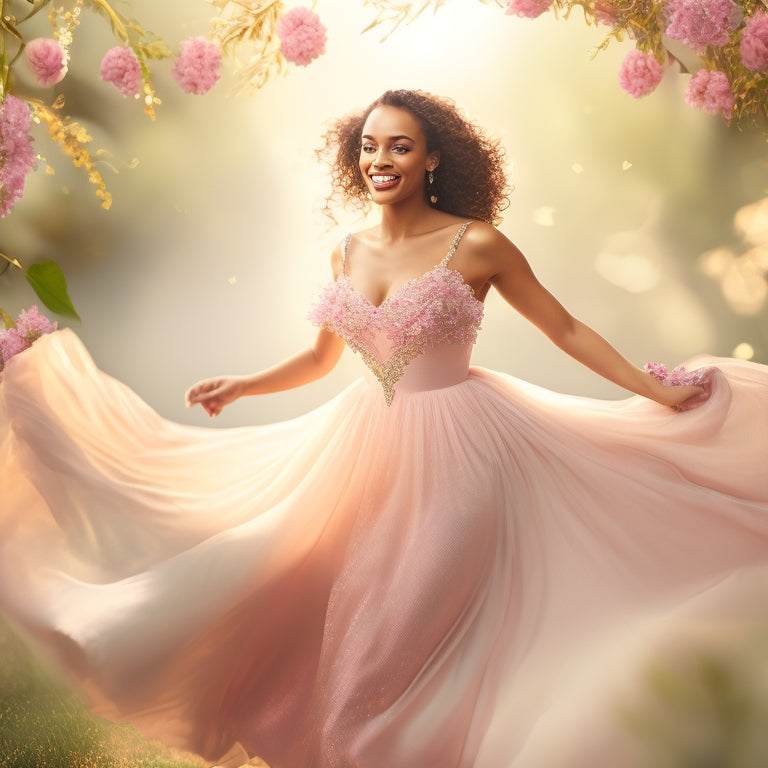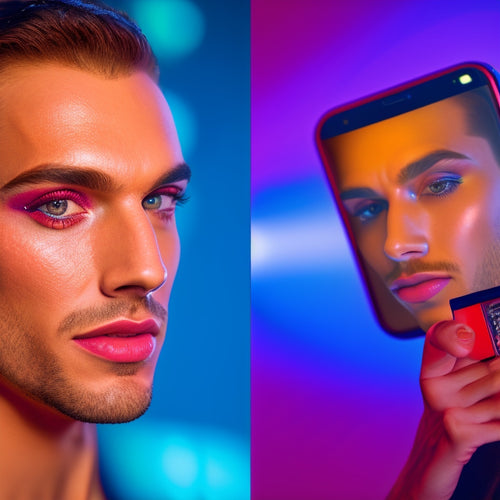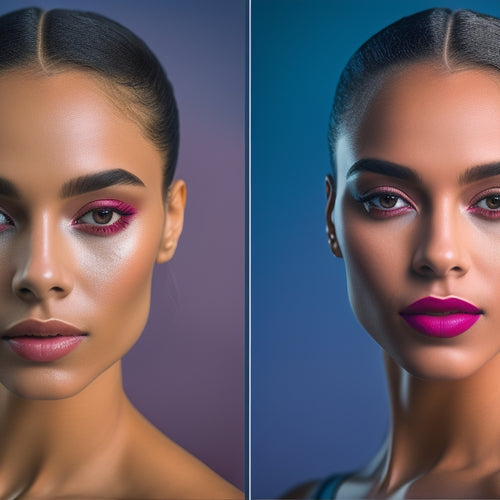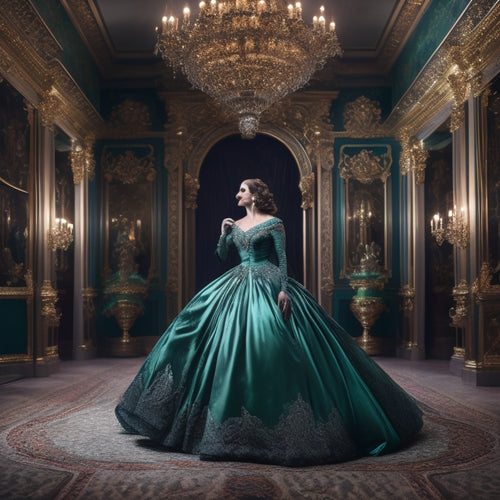
How Can I Look Pretty When Dancing?
Share
You want to look pretty when dancing? Start by mastering your dance floor posture: elongate your spine, relax your shoulders, and engage your core. Choose a dance outfit that complements your posture and suits your style. Sweat-friendly hair and makeup products will keep you fresh and confident. Perfect your dance technique through practice, and focus on musicality, body awareness, and breath control to add elegance to your movements. As you refine your skills, you'll exude confidence and style, and that's when the real magic happens - discover the secrets to revealing your full dance potential.
Key Takeaways
• Maintain an elongated spine and relaxed shoulders to create a confident and elegant posture while dancing.
• Choose a dance outfit that complements your posture and allows for freedom of movement, selecting breathable and elegant fabrics.
• Opt for sweat-friendly hair and makeup products that enhance your natural features and stay in place throughout your performance.
• Emphasize your striking physical attributes through body positioning and techniques like Facial Framing and Body Contouring.
• Exude confidence by owning the dance floor, standing tall, and making eye contact with the music, allowing your unique style to shine through.
Mastering Your Dance Floor Posture
As you step onto the dance floor, maintaining a tall, elongated spine and relaxed shoulders is crucial for mastering your posture. It's important to engage your core muscles, drawing your belly button towards your spine, which will help stabilize your body.
This core engagement will allow you to maintain a long, lean line from head to heels. Meanwhile, focus on shoulder alignment, keeping them down and away from your ears. Avoid slouching or scrunching, as this will make you appear shorter and less confident.
Choosing the Right Dance Outfit
You'll want to select a dance outfit that complements your newfound posture, allowing you to move freely and confidently while accentuating your best features. Consider the dance fabrics and outfit layers that will make you feel empowered and unrestricted.
| Dance Fabrics | Characteristics |
|---|---|
| Lycra/Spandex | Stretchy, form-fitting, breathable |
| Cotton/Poly Blend | Soft, durable, easy care |
| Silk/Lace | Elegant, sophisticated, delicate |
| Mesh/Nylon | Ventilated, lightweight, quick-drying |
Choose fabrics that suit your dance style and personal preferences. Opt for breathable, moisture-wicking fabrics for high-intensity dances, or go for elegant, flowing fabrics for more expressive styles. Consider layering a flowy top over a fitted leotard or pairing a flowy skirt with leggings. The right outfit will enhance your confidence and freedom of movement.
Hair and Makeup for Dancing
With every step, spin, and leap, your hairstyle and makeup should stay in place, framing your face and accentuating your best features. To achieve a stage-ready look, opt for sweat-friendly products that can withstand your intense dance routine.
For hair, choose a style that's secure yet allows for movement, such as a high ponytail or a braided updo. Use hairspray to keep stray hairs in place and add a light-hold hair wax for extra hold.
For makeup, select products labeled 'sweat-resistant' or 'long-lasting' to make certain your look stays fresh throughout the performance. Focus on enhancing your natural features with subtle, natural shades, and don't forget to set your look with a setting spray.
With these tips, you'll be confident that your hair and makeup will stay in place, allowing you to focus on your dance moves.
Building Confidence Through Practice
By perfecting your dance technique through consistent practice, you'll develop muscle memory, allowing your body to execute movements with precision and confidence.
As you rehearse, focus on mental preparation, visualizing yourself performing flawlessly. Repeat positive affirmations to yourself, such as 'I am capable and strong' or 'I trust my body to move with grace.' This mental preparation will translate to confidence on the dance floor.
With each practice, you'll feel more assured in your movements, and your body will respond with fluidity and poise. As you build confidence, you'll start to own the dance floor, moving with freedom and expression.
Dancing With Style and Elegance
As you take the dance floor, focus on projecting an aura of sophistication, letting your movements exude refinement and poise. To achieve this, remember that dancing with style and elegance isn't just about the steps, but about the way you execute them.
Here are some tips to help you refine your dance:
-
Develop your musicality: Listen to the rhythm and let it guide your movements.
-
Cultivate body awareness: Be mindful of your posture, alignment, and weight transfer.
-
Use your breath: Breathe life into your movements, and let your body relax into the music.
Accentuating Your Best Features
You accentuate your best features by highlighting your facial expressions, showcasing your brightest smile, and emphasizing your most striking physical attributes through intentional body positioning. This is achieved through techniques like Facial Framing, where you subtly angle your face to accentuate your best features, and Body Contouring, where you position your body to create a more streamlined silhouette.
| Feature | Technique | Effect |
|---|---|---|
| Eyes | Facial Framing | Accentuates eye shape and size |
| Smile | Brightening | Creates a radiant, approachable demeanor |
| Posture | Body Contouring | Elongates the body, creates confidence |
| Hair | Flowing Movement | Adds dynamic energy to your dance |
Creating a Flawless Dance Routine
With your best features accentuated, it's time to focus on crafting a dance routine that showcases your polished style and technique. A flawless routine requires careful planning and collaboration.
Here are three essential steps to get you started:
-
Musicality Exploration:
Explore the rhythm, melody, and harmony of your chosen song. Identify the emotional peaks and valleys to inform your choreography. -
Choreographer Collaboration:
Work with a choreographer to create a custom routine that highlights your strengths and hides your weaknesses. -
Rehearsal and Refining:
Rehearse your routine until it becomes second nature, making adjustments as needed to perfect the performance.
Exuding Confidence on the Dance Floor
Embracing a mindset shift, you transform into a confident dancer by owning the dance floor with every step, gesture, and movement. As you take the floor, focus on mindful breathing, feeling the rhythm course through your veins.
Your body language speaks volumes, so stand tall, relax your shoulders, and let your arms flow freely. Make eye contact, not with the audience, but with the music itself. You're not just dancing; you're having a conversation with the rhythm.
With each step, you assert your presence, claiming your space on the dance floor. Own it, and the audience will respond in kind, drawn to your infectious confidence. As you move, remember, it's not about perfection – it's about freedom, expression, and the joy of letting go.
Embracing Your Unique Dance Style
As you step onto the dance floor, remember that your unique style is what sets you apart.
By embracing your individuality, you'll exude a confidence that's infectious and enchanting.
Own Your Moves
By claiming your unique dance style, you're more likely to exude confidence and authenticity on the dance floor, making every step feel like a natural extension of yourself. This self-acceptance allows you to tap into your Emotional Expression, revealing a Personal Swagger that's impossible to ignore.
Here are three key benefits of owning your moves:
-
Fearless Abandon: You'll dance with reckless abandon, unafraid to take risks and try new things.
-
Unbridled Creativity: Your unique style will shine, and you'll find innovative ways to express yourself through movement.
-
Unstoppable Confidence: You'll own the dance floor, radiating an aura of self-assurance that draws others in.
Express Yourself Freely
You'll find that owning your moves gives you the freedom to express yourself freely, unfettered by the need to conform to traditional techniques or mimic others.
As you release inhibitions, you'll tap into your unique dance style, awakening a sense of spontaneity and creativity.
Embrace this freedom, and you'll find your movements becoming more fluid, more natural, and more authentic.
Don't be afraid to experiment, to try new things, and to make mistakes. It's in these moments of uncertainty that true artistry is born.
So, let go of self-doubt, and let your true self shine through in your dance.
Frequently Asked Questions
What Are Some Exercises to Improve My Overall Flexibility for Dancing?
As you coincidentally stumble upon a hidden flexibility, you'll find that incorporating hamstring stretches and hip circles into your daily routine will increase your range of motion, allowing you to move with fluid grace.
How Do I Prevent Sweating Excessively While Dancing?
When dancing, you'll want to prevent excessive sweating by applying antiperspirant options, such as clinical-strength formulas or natural alternatives, and wear sweat-resistant fabrics like moisture-wicking polyester or breathable mesh to keep you cool and confident.
Can I Wear Contact Lenses While Dancing?
When you wear contact lenses while dancing, prioritize Lens Care to avoid Eye Irritation; gently clean your lenses before and after dancing, and consider daily disposables to minimize risks, ensuring freedom to move with confidence.
What if I Have a Body Odor Issue While Dancing?
Did you know that 75% of people experience body odor anxiety? You can tackle this issue by using odor-fighting products and practicing good hygiene. Boost your confidence with antiperspirants, deodorants, and natural remedies like tea tree oil and apple cider vinegar.
Can I Dance in Heels if I Have Flat Feet?
If you have flat feet, you can still dance in heels by opting for heel modifications, such as a thicker heel or a rocker sole, and practicing foot rolls to redistribute pressure and alleviate discomfort.
Related Posts
-

7 Downloadable Dance Makeup Tutorials for Men
You're about to access a world of bold, edgy, and mesmerizing dance makeup looks with these 7 downloadable tutorials ...
-

Why Lyrical Dancers Need Pro Makeup Guidance Online
As a lyrical dancer, you know that a polished, performance-ready look is essential to showcasing your skills and conv...
-

Dance Maestro Zoe Rappaport Steals the Spotlight
Zoe Rappaport's illustrious career has cemented her status as a visionary Maestro, driving innovation in movement dir...


